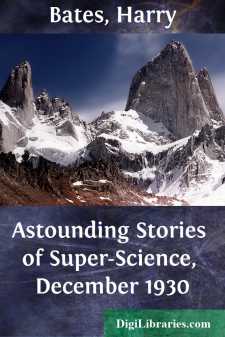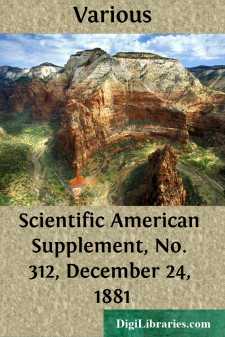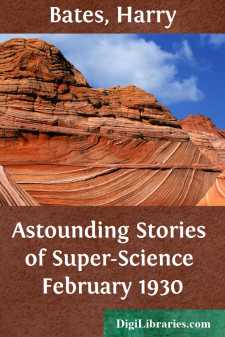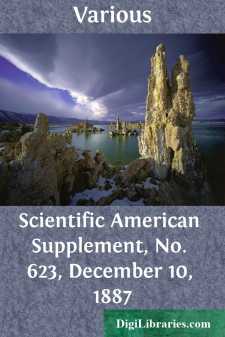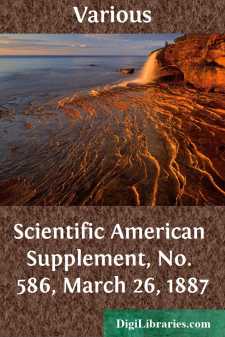Periodicals
- Art 27
- Children's periodicals 59
- Entertainment 5
- Food/Wine 2
- Games/Humor 455
- General 661
- Health 1
- History 53
- House/Home 1
- Regional 62
- Science/Nature
- Transportation 10
Science/Nature Books
Sort by:
by:
Various
DR. MORELL MACKENZIE. The name of the great English laryngologist, which has long been honored by scientists of England and the Continent, has lately become familar to everyone, even in unprofessional circles, in Germany because of his operations on the Crown Prince's throat. If his wide experience and great skill enable him to permanently remove the growth from the throat of his royal patient, if...
more...
by:
Harry Bates
batalões turned from the open waters of the lower Tapajos River into the igarapé, the lily-smothered shallows that often mark an Indian settlement in the jungles of Brazil. One of the two half-breed rubber-gatherers suddenly stopped his batalõe by thrusting a paddle against a giant clump of lilies. In a corruption of the Tupi dialect, he called over to the white man occupying the other frail craft....
more...
by:
Various
THE FRANKFORT AND OFFENBACH ELECTRIC RAILWAY. The electric railway recently set in operation between Frankfort and Offenbach furnishes an occasion for studying the question of such roads anew and from a practical standpoint. For elevated railways Messrs. Siemens and Halske a long time ago chose rails as current conductors. The electric railway from Berlin to Lichterfelde and the one at Vienna are in...
more...
by:
Various
IMPROVED FIFTEEN TON CRANE. IMPROVED FIFTEEN TON TRAVELING CRANE.The machine illustrated on first page has been constructed for Port Alfred Harbor, this being one of several harbors now being made by Sir J. Coode in South Africa. The pier for the construction of which the crane will be employed will consist of concrete blocks laid on what is known as the "overend system." The blocks, being...
more...
by:
Harry Bates
onfound it, Carnes, I am on my vacation!” “I know it, Doctor, and I hate to disturb you, but I felt that I simply had to. I have one of the weirdest cases on my hands that I have ever been mixed up in and I think that you’ll forgive me for calling you when I tell you about it.” How could a human body be found actually splintered––broken into sharp fragments like a shattered glass! Once...
more...
by:
Harry Bates
Two miles west of the village of Laketon there lived an aged recluse who was known only as Old Crompton. As far back as the villagers could remember he had visited the town regularly twice a month, each time tottering his lonely way homeward with a load of provisions. He appeared to be well supplied with funds, but purchased sparingly as became a miserly hermit. And so vicious was his tongue that few...
more...
by:
Various
NOTE ON THE CONSTRUCTION OF A DISTILLERY CHIMNEY. FIG. 1—ELEVATION. At a recent meeting of the Industrial Society of Amiens, Mr. Schmidt, engineer of the Steam Users' Association, read a paper in which he described the process employed in the construction of a large chimney of peculiar character for the Rocourt distillery, at St. Quentin. This chimney, which is cylindrical in form, is 140 feet...
more...
by:
Various
THE USE OF IRON IN FORTIFICATION. Roumania is thinking of protecting a portion of the artillery of the forts surrounding her capital by metallic cupolas. But, before deciding upon the mode of constructing these formidable and costly affairs, and before ordering them, she has desired to ascertain their efficacy and the respective merits of the chilled iron armor which was recently in fashion and of...
more...
by:
Various
THE RETIRO VIADUCT. We give engravings of the viaduct over the river Retiro, Brazil, our illustrations being reproduced by permission from the Proceedings of the Institution of Civil Engineers. In a "selected paper" contributed to the volume of these proceedings just published, Mr. Jorge Rademaker Grunewald, Memb. Inst. C.E., describes the work as follows: VIADUCT OVER THE RETIRO, BRAZIL....
more...
by:
Various
BRISTOL CATHEDRAL. BRISTOL CATHEDRAL. An Augustinian monastery, founded by Robert Fitzhardinge in 1142, had its church, of Norman architecture, to which additions were made in the early English period. When Edmund Knowle was abbot, from 1306 to 1332, the Norman choir was replaced by that which now exists. His successor, Abbot Snow, built the chapels on the south side of the choir. Abbot Newland,...
more...



